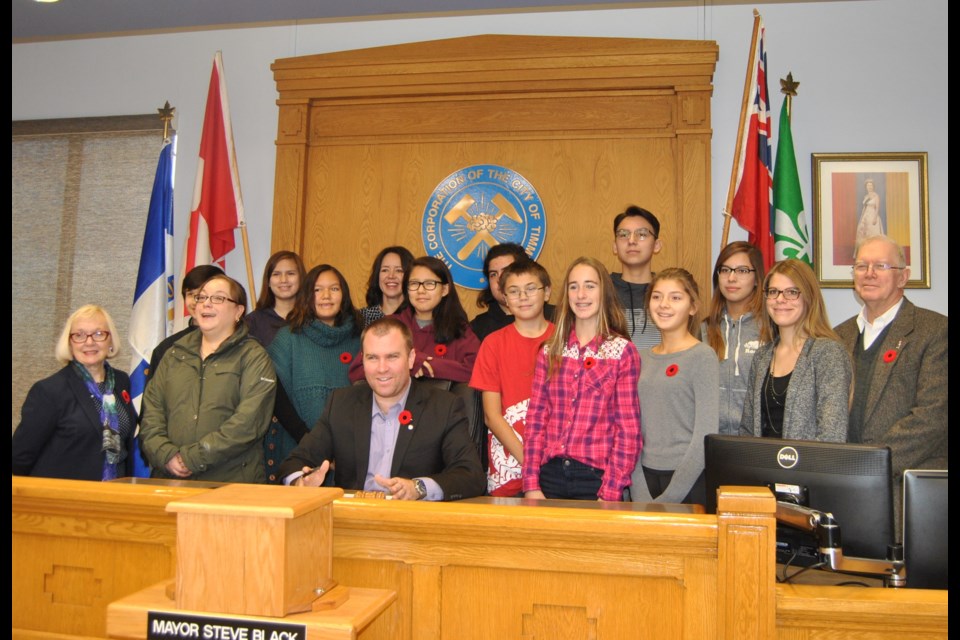The City of Timmins and District School Board Ontario North East (DSBONE) declared the week of November 6 to 12 as Treaties Recognition Week, as part of Ontario’s implementation of recommendations contained in the Truth and Reconciliation process in residential schools.
“We are pleased to be here today to formally recognize this important week – Treaties Recognition Week,” said Lisa Innes, the first Indigenous System Lead coordinator for DSBONE.
“When you look at the change of direction from the provincial and federal governments and the importance that they place on recognizing the treaties and the history and the process behind them is a great step forward,” said Timmins Mayor Steve Black in signing the proclamation for the City of Timmins.
“When I was in school we learned very little about First Nation history and culture and that is a big gap that needs to be addressed,” Mayor Black added.
“This is a great learning opportunity for me and for the students as well,” Mayor Black continued. ““It’s been a great honour to work with Chief Walter Naveau of the Mattagami First Nations over the years, and he has been a great resource in teaching me about this area, which is the traditional homeland of the Mattagami First Nation and I have enjoyed working in partnership with him.”
Lisa Innes explained that the Indigenous Systems Lead is new and is part of Ontario’s implementation of the Truth and Reconciliation recommendations.
“At DSBONE, we believe all students, both indigenous and non-Indigenous are enriched by learning about the histories, cultures and contributions and perspectives of indigenous peoples in Canada,” Innes said.
The Ministry of Indigenous Relations and Reconciliation (MIRR) earlier this year designated November 6-12, 2016 as Treaties Recognition Week. The goal of this week is to promote public education and awareness about treaties and treaty relationships.
In 1905, the Ojibway and Cree people of Northern Ontario entered into a treaty relationship with the Government of Canada with the signing of Treaty 9.
In agreeing to share the land the Indigenous people were given hunting and fishing rights, reserve areas and a monetary gift. In return, the Indigenous people agreed to share the natural resources of the land.
“This today is a topic of conversation, both in and out of the school setting,” noted Innes. "It is important to share the facts and the history of the treaty process.”
In October, at a mining conference hosted by the Nishnawbe Aski Development Fund in Timmins, Grand Chief Jonathan Solomon of Mushkegowuk Council, disputed the written Treaty 9.
He claimed that Treaty 9 is not what was promised verbally to elders.
Grand Chief Solomon pointed to the Daniel McMartin diaries, the Ontario representative on the three member negotiating team, which details the oral commitments made to elders. Solomon said these commitments were not included in the written treaty. Solomon also stated that McMartin also does not include reference the taking up of lands when required by the province without consultations, thus indicating that section was never communicated to the elders of the Cree and Ojibway communities in 1905.
Each Ontario school board will now have an Indigenous Systems Lead position to include the history and culture of Ontario’s First Nation into the educational curriculum of their area and the teach about the details of the particular treaty that was signed with their local First Nations.
“One of the biggest challenges is to make people aware that introducing the teaching of Indigenous history and treaty recognition is that it involves everybody,” Innes said. “The issues we talk about are issues that involve all Canadians.”
According to Innes, this could be a first step in addressing the inequalities in the federally run on reserve schools and could see the provinces playing a greater role in Indigenous education.
Since pre-confederation a number of treaties were signed with First Nations in Ontario.
https://www.ontario.ca/page/treaties
The treaties signed with First Nations are:
Pre-Confederation:
- The Treaties of Fort Niagara (1764, 1781)
- The Crawford Purchases (1783-1784) mostly covering southern Ontario, and reaching as far as the Bruce Peninsula and Manitoulin Island
- Robinson treaties of 1850 signed with Ojibway communities living along the north shores of Lakes Huron and Superior
Post-confederation treaties, 1873-1930
- Treaties 3, 5, and 9 were signed with Ojibway and Cree communities in Northern Ontario.
- Treaty No. 9 which includes the area from James Bay down through south of Timmins is also called “The James Bay Treaty.”
- The Williams treaties, 1923 were signed with Chippewas of Lake Simcoe, Lake Huron and the Mississaugas of Rice Lake, Scugog, Curve Lake and Alderville in central Ontario.
